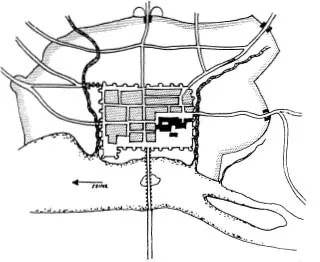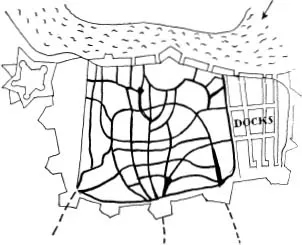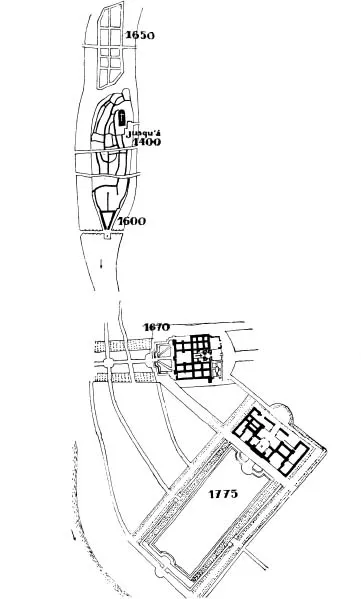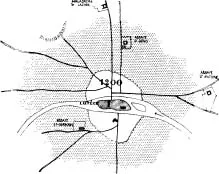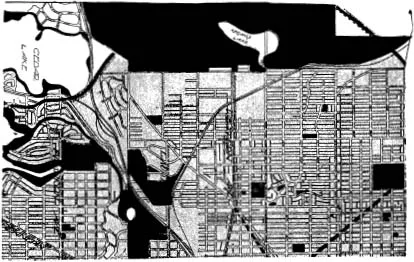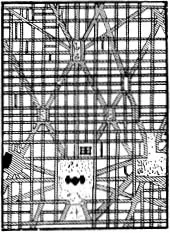![]()
FIRST PART
GENERAL CONSIDERATIONS
Man walks in a straight line because he has a goal and knows where he is going; he has made up his mind to reach some particular place and he goes straight to it.
![]()
ROUEN IN THE TENTH CENTURY, BUILT ON THE RECTILINEAR ROMAN PLAN
The cathedral was built on the site of the ancient public buildings. In 1750 the new wall took in the neighbouring approaches ; the fate of the town was decided. The heart of the city has remained rectilinear throughout the ages.
I
THE PACK-DONKEY’S WAY AND MAN’S WAY
MAN walks in a straight line because he has a goal and knows where he is going ; he has made up his mind to reach some particular place and he goes straight to it.
The pack-donkey meanders along, meditates a little in his scatter-brained and distracted fashion, he zigzags in order to avoid the larger stones, or to ease the climb, or to gain a little shade ; he takes the line of least resistance.
But man governs his feelings by his reason ; he keeps his feelings and his instincts in check, subordinating them to the aim he has in view. He rules the brute creation by his intelligence. His intelligence formulates laws which are the product of experience. His experience is born of work; man works in order that he may not perish. In order that production may be possible, a line of conduct is essential, the laws of experience must be obeyed. Man must consider the result in advance.
But the pack-donkey thinks of nothing at all, except what will save himself trouble.
*
The Pack-Donkey’s Way is responsible for the plan of every continental city ; including Paris, unfortunately.
ANTWERP IN THE SEVENTEENTH CENTURY
The city has grown year by year, its plan being dictated by the existing roads leading to it. The result is an ingenious series of adaptations made during many centuries. None the less, the plan is a fine one of a curvilinear type.
In the areas into which little by little invading populations filtered, the covered wagon lumbered along at the mercy of bumps and hollows, of rocks or mire ; a stream was an intimidating obstacle. In this way were born roads and tracks. At cross roads or along river banks the first huts were erected, the first houses and the first villages ; the houses were planted along the tracks, along the Pack-Donkey’s Way. The inhabitants built a fortified wall round and a town hall inside it. They legislated, they toiled, they lived, and always they respected the Pack-Donkey’s Way. Five centuries later another and larger enclosure was built, and five centuries later still a third yet greater. The places where the Pack-Donkey’s Way entered the town became the City Gates and the Customs officers were installed there. The village has become a great capital; Paris, Rome, and Stamboul are based upon the Pack-Donkey’s Way.
The great capitals have no arteries ; they have only capillaries : further growth, therefore, implies sickness or death. In order to survive, their existence has for a long time been in the hands of surgeons who operate constantly.
The Romans were great legislators, great colonizers, great administrators. When they arrived at a place, at a cross roads or at a river bank, they took a square and set out the plan of a rectilinear town, so that it should be clear and well-arranged, easy to police and to clean, a place in which you could find your way about and stroll with comfort—the working town or the pleasure town (Pompeii). The square plan was in conformity with the dignity of the Roman citizen.
But at home, in Rome itself, with their eyes turned towards the Empire, they allowed themselves to be stifled by the Pack-Donkey’s Way. What an ironical situation ! The wealthy, however, went far from the chaos of the town and built their great and well-planned villas, such as Hadrian’s villa.
ULM : THE ANCIENT STRATIFIED ENCAMPMENT
Six centuries later, everything remains the same !
They were, with Louis XIV, the only great town-planners of the West.
In the Middle Ages, overcome by the year 1000, men accepted the leading of the pack-donkey, and long generations endured it after. Louis XIV, after trying to tidy up the Louvre (i.e. the Colonnade), became disgusted and took bold measures : he built Versailles, where both town and chateau were created in every detail in a rectilinear and well-planned fashion ; the Observatoire, the Invalides and the Esplanade, the Tuileries and the Champs Élysées, rose far from the chaos, outside the town ;—all these were ordered and rectilinear.
The overcrowding had been exorcised. Everything else followed, in a masterly way : the Champ de Mars, I’Etoile, the avenues de Neuilly, de Vincennes, de Fontainebleau, etc., for succeeding generations to exploit.
But imperceptibly, as a result of carelessness, weakness and anarchy, and by the system of “democratic” responsibilities, the old business of overcrowding began again.
And as if that were not enough, people began to desire it; they have even created it in invoking the laws of beauty ! The Pack-Donkey’s Way has been made into a religion.
*
The movement arose in Germany as a result of a book by Camille Sitte on town-planning, a most wilful piece of work ; a glorification of the curved line and a specious demonstration of its unrivalled beauties. Proof of this was advanced by the example of all the beautiful towns of the Middle Ages ; the author confounded the picturesque with the conditions vital to the existence of a city. Quite recently whole quarters have been constructed in Germany based on this æsthetic. (For it was purely a question of æsthetics.)
PARIS : THE CITÉ, THE PLACE DAUPHINE, L’ÎLE SAINT-LOUIS, THE INVALIDES, L’ÉCOLE MILITAIRE
A significant diagram. These outline drawings, which are all to the same scale, show the trend towards order. The town is being policed, culture is manifesting itself and Man is able to create.
This was an appalling and paradoxical misconception in an age of motor-cars. “So much the better,” said a great authority to me, one of those who direct and elaborate the plans for the extension of Paris ; “motors will be completely held up !”
But a modern city lives by the straight line, inevitably ; for the construction of buildings, sewers and tunnels, highways, pavements. The circulation of traffic demands the straight line ; it is the proper thing for the heart of a city. The curve is ruinous, difficult and dangerous ; it is a paralyzing thing.
FIRST LUTETIA, THEN PARIS
The buildings still occupy the original sites, e.g. Notre-Dame, le Palais. The great provincial roads, from north, east and south, from Issy, from Clichy, from the maritime provinces, and from the temple of Mercury (Montmartre), all remain. Later, the Abbeys form definite landmarks. As far as town planning is concerned, there is nothing but chance and the taking the line of least resistance. Haussmann, later on, will open up and remodel the city to the best of his ability. But it still remains based on the “Pack-Donkey’s Way.”
The straight line enters into all human history, into all human aim, into every human act.
We must have the courage to view the rectilinear cities of America with admiration. If the aesthete has not so far done so, the moralist, on the contrary, may well find more food for reflection than at first appears.
*
MINNEAPOLIS (A FRAGMENT)
This gives us an indication of a new moral outlook in social life, and provides some clue to the mutual astonishment which Americans and Europeans can cause one another to feel. Our epoch has now reached a stage in which the Old World must react to the new conditions and must consider the question of Town Planning.
WASHINGTON (A FRAGMENT)
A work of the mind. Here the victory is on the other side ; there were no more Pack-Donkey’s Ways when this plan was designed, but instead there were Railways. The æsthetic problem still remains.
The winding road is the Pack-Donkey’s Way, the straight road is man’s way.
The winding road is the result of happy-go-lucky heedlessness, of looseness, lack of concentration and animality.
The straight road is a reaction, an action, a positive deed, the result of self-mastery. It is sane and noble.
A city is a centre of intense life and effort.
A heedless people, or society, or town, in which effort is relaxed and is not concentrated, quickly becomes dissipated, overcome and absorbed by a nation or a society that goes to work in a positive way and controls itself.
It is in this way that cities sink to nothing and that ruling classes are overthrown.
*
ANDROUET DU CERCEAU (RENAISSANCE)
The Artist and the Planner have been at work
The right angle is the e...

